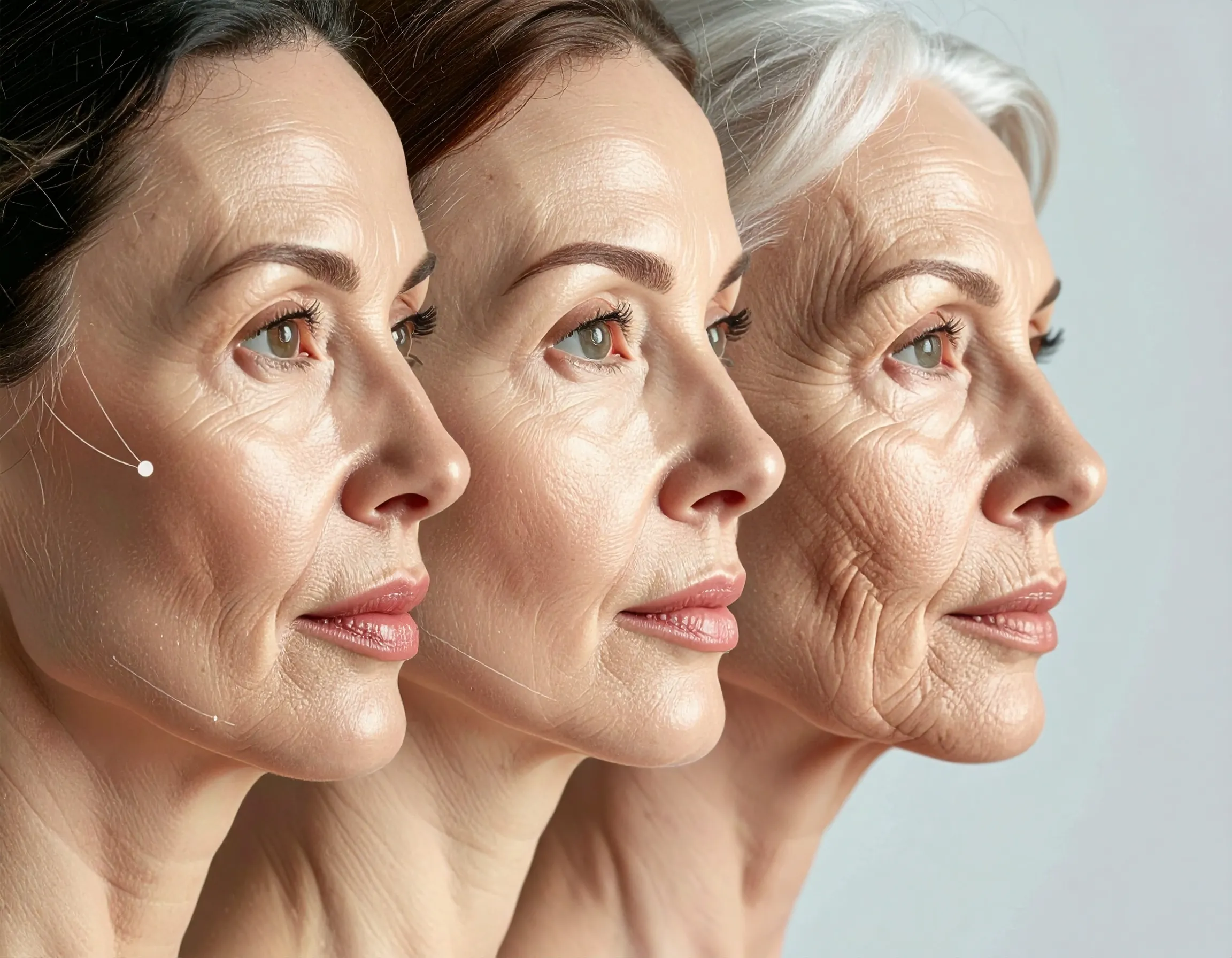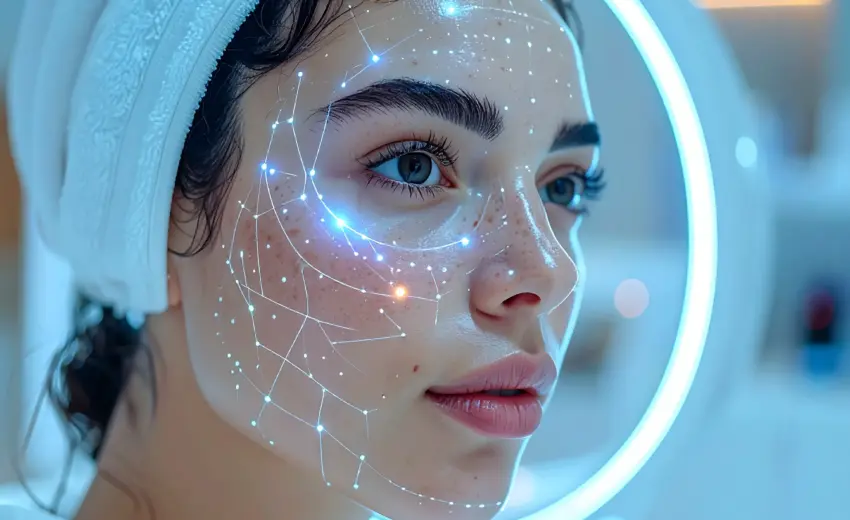Have you ever wondered why serum effectiveness varies so dramatically from person to person? Skin is an incredibly complex organ shaped by biology, lifestyle, and environment, making the quest for perfect skincare far from one-size-fits-all. I’ve spent years exploring the world of skincare, and one thing has become abundantly clear: a cream that works wonders for one person can irritate another.
This is precisely why personalization has become the next frontier in skincare. When comparing vitamin C serum effectiveness, collagen serum effectiveness, or even the broader serum vs cream effectiveness debate, the application method matters significantly. Traditional manual application has been the standard for decades. However, smart devices promising enhanced absorption and personalized delivery are now challenging this approach. These AI-powered tools analyze minute skin details that the naked eye may miss and provide ongoing monitoring to track progress and adapt recommendations over time.
By tuning regimens to individual biology and context, personalization reduces guesswork, improves outcomes, and saves us from the endless cycle of trial and error. Despite the technological promises, many wonder: is the investment in smart skincare technology truly worth it? In this article, we’ll explore both approaches to help you decide which method might deliver the best results for your unique skin needs.

Understanding the Two Approaches: Smart Devices vs Traditional Application
The effectiveness of any skincare product depends not only on its formulation but also on how it’s delivered to the skin. Traditional manual application and smart device-assisted application represent two distinct approaches to maximizing serum effectiveness.
How traditional serum application works
Traditional serum application follows a time-tested, straightforward process that begins with proper skin preparation. Initially, cleansing is essential to remove makeup, dirt, and impurities that could hinder absorption. Using circular motions with a gentle cleanser creates a clean canvas for serum application. After cleansing, the skin should be patted dry—not rubbed—to avoid irritation.
For the actual application, a small amount of serum (typically 3-6 drops or pea-sized) is dispensed into the palm. The serum is then applied using light upward movements across the face and neck, followed by gentle tapping motions to enhance absorption. This upward motion is crucial as downward pulling can potentially contribute to skin sagging over time.
After the serum has been fully absorbed, applying moisturizer helps seal in the active ingredients and prevents moisture loss by creating a protective barrier. This final step is vital for locking key ingredients into the skin and maximizing serum effectiveness.
What defines a smart skincare device
Smart skincare devices are technology-enabled applicators that optimize how serums and other products interact with the skin. Unlike traditional methods, these devices enhance absorption, target delivery, and adapt based on individual skin needs. They often connect to apps or digital platforms that provide customized skincare routines and progress tracking.
What truly sets smart devices apart is their ability to address a fundamental limitation of traditional application: penetration depth. These tools don’t replace formulations but rather unlock their full potential by maximizing the absorption of active ingredients such as peptides, antioxidants, and retinol. Additionally, they can target specific skin zones with greater accuracy, reducing product waste by delivering precisely what’s needed where it’s needed.
Moreover, many smart devices offer reminder systems that keep skincare routines top of mind—a significant benefit for those who might otherwise forget their routine steps.
Examples of smart serum delivery systems
The market now offers various sophisticated smart delivery systems designed to enhance serum effectiveness:
The SkinSense Smart Brush exemplifies advanced application technology with its focus on the delicate eye area. This device combines multiple technologies:
- Phototherapy (630nm red light) to stimulate collagen and reduce fine lines
- Microcurrent that energizes skin and tones facial muscles
- Thermal conduction to gently warm skin, opening pores for increased absorption
- NFC skin analysis that adjusts stimulation based on individual skin condition
NuFACE represents another innovation in smart skincare. This microcurrent tool stimulates facial muscles for contouring and lifting effects. Through smartphone connectivity, users access different treatment protocols tailored to specific goals like toning or lifting. The selected mode directly impacts the device’s energy output and therefore its effectiveness.
Furthermore, apps like TroveSkin and +SABI AI enhance the smart device experience by tracking detailed information including sleep patterns, stress levels, nutrition, exercise, and water intake—creating a comprehensive picture of factors affecting skin health.
Serum Absorption and Delivery Efficiency
The science of skin penetration lies at the heart of effective skincare. While formulations matter, delivery mechanisms ultimately determine how much of those active ingredients actually reach their targets within the skin.
Penetration depth: manual vs device-assisted application
Traditional application methods face a fundamental challenge: the skin’s natural barrier. When comparing manual versus device-assisted application, timing plays a crucial role. Studies show that when ink is applied before microneedling pen treatment, penetration depth is significantly greater compared to application after treatment at both 1 and 3-hour intervals. Notably, microneedling demonstrates not only deeper penetration but also lateral extension of product beyond microchannels, with penetration increasing over time.
Penetration depth correlates directly with needle length, increasing by approximately 0.06 mm for every 1 mm increase in needle length. In contrast, manual application primarily affects only the stratum corneum, limiting absorption primarily to smaller molecules.
Factors affecting serum penetration include:
- Molecular size of active ingredients
- Application method and timing
- Skin preparation and condition
- Device type and settings
Smart device technologies: microcurrents, ultrasound, LED
Microcurrent devices represent a major advancement in serum delivery. These tools stimulate facial muscles through gentle electrical currents, enhancing circulation while simultaneously boosting collagen production. For optimal results, a conductive gel must be used as a bridge between device and skin, allowing currents to travel efficiently across treatment areas.
Ultrasonic devices operate on a different principle. Through ultrasonic waves, these scrubbers loosen and remove dead skin cells while simultaneously improving product absorption by ensuring a cleaner surface.
LED therapy complements these approaches, particularly for specific serums. Red light therapy (630nm wavelength) specifically promotes collagen production and cellular repair, whereas blue light targets acne-causing bacteria. These technologies work in concert with serums – warming thermotherapy opens pores while cooling cryotherapy tightens skin and reduces inflammation, both enhancing absorption.
Impact on hyaluronic acid and collagen serum effectiveness
Hyaluronic acid (HA) serums face a molecular weight challenge in traditional application. Research confirms that only low molecular weight HA (20-300 kDa) effectively passes through the stratum corneum, while high molecular weight HA (1000-1400 kDa) remains largely impermeable.
Device-assisted application dramatically improves hyaluronic acid serum effectiveness. One study demonstrated that properly formulated HA produced a 134% immediate increase in skin water content, with continued improvement showing 15% increase at 2 weeks, 29% at 4 weeks, and 55% at 6 weeks.
For collagen serums, microcurrent therapy particularly excels by stimulating ATP production in mitochondria, consequently enhancing both collagen and elastin production. This addresses sagging and wrinkles more effectively than manual application alone.

Personalization and Adaptability of Skincare Routines
Beyond formulation and delivery methods, the future of serum effectiveness hinges on personalization. The skincare industry is rapidly evolving from generic solutions to tailored regimens that adapt to individual needs in real time.
AI-driven customization in smart devices
Advanced AI technologies in skincare devices now analyze intrinsic factors such as skin type, pigmentation, and texture alongside external influences like product ingredients and environmental conditions. This comprehensive data integration allows for sophisticated prediction of long-term skin health outcomes with greater precision. L’Oréal’s Perso exemplifies this technology—a 6.5-inch device that creates personalized skincare formulas by analyzing skin condition through smartphone photos, environmental data, and personal preferences.
The most advanced systems employ machine learning to optimize formulations based on clinical studies, ingredient performance, and user feedback. These platforms continuously refine their recommendations as they gather more information about an individual’s skin, creating increasingly effective personalized regimens over time.
Static vs adaptive routines in traditional methods
Traditional skincare approaches often treat routines as fixed and formulaic, failing to account for skin’s fluid nature as it responds to seasons, stress, and environmental changes. Although conventional methods may categorize skin broadly (dry, oily, combination), they lack the nuance required for truly personalized care.
In stark contrast, AI-powered systems dynamically adjust recommendations based on real-time data. For example, on days with high UV exposure, smart devices might suggest products with increased SPF protection or antioxidants. This adaptability enhances serum effectiveness by ensuring active ingredients match current skin conditions rather than following predetermined routines that may not align with evolving needs.
Feedback loops and real-time skin monitoring
Emerging wearable technologies represent a quantum leap in personalization through continuous monitoring. Advanced devices can track skin metrics including hydration levels, pH balance, and transepidermal water loss in real time. This information creates feedback loops that trigger automatic adjustments to skincare recommendations.
The latest innovations include waterproof, epidermal microfluidic devices that analyze sweat composition with high accuracy, and compact sensors measuring water vapor, volatile organic compounds, and carbon dioxide fluxes through skin. These technologies seamlessly integrate with smartphone applications, allowing users to monitor skin health and receive personalized alerts that significantly enhance adherence to skincare regimens.
By continually learning from user behavior and physiological changes, these systems create truly responsive skincare routines that maximize serum effectiveness regardless of changing internal and external conditions.
Scientific Evidence and Effectiveness Studies
Research forms the foundation for making informed choices about skincare technologies. Clinical studies provide valuable insights into how different application methods impact overall serum effectiveness.
Vitamin C serum effectiveness: device vs manual
Clinical evidence demonstrates that vitamin C serums applied with devices achieve superior penetration compared to manual methods. Studies reveal that timing plays a crucial role – when applied before device treatments, penetration depth increases significantly at both 1-hour and 3-hour intervals. Device-assisted application achieves both deeper penetration and lateral product extension beyond the initial application area, with absorption increasing progressively over time.
Hair growth serum effectiveness studies with Bodywise and others
Hair growth serums backed by clinical research show promising results. According to clinical studies registered with the Clinical Trial Registry of India, Bodywise Hair Growth Serum demonstrated that 90% of women experienced reduced hair fall. This serum contains 3% Redensyl, 3% Procapil, and 2% Baicapil alongside natural DHT blockers like 5% Saw Palmetto. For optimal results, consistent use for at least 3 months is recommended. Other studies examining formulations with amla extract, freeze-dried coconut water, and selenopeptide showed a 57.53% reduction in hair fall with bulb and 81.60% reduction in hair fall without bulb by study completion.
Eyebrow growth serum effectiveness: anecdotal vs clinical data
Looking beyond anecdotal claims, eyebrow growth serums have undergone rigorous clinical evaluation. A three-armed randomized trial compared 0.03% bimatoprost, 0.01% bimatoprost, and 2% minoxidil for eyebrow hypotrichosis, with all three groups showing significant improvement in hair diameter at 16 weeks. Commercial products like Augustinus Bader’s Eyebrow and Lash Enhancing Serum report impressive 12-week clinical trial results: 34% increase in lash length and 55% improvement in eyebrow thickness.
Serum vs cream effectiveness: what research shows
Research indicates that serums generally deliver more concentrated active ingredients than creams. Harvard Health confirms that serums with vitamin C, vitamin E, and ferulic acid combination effectively prevent brown spots, reverse UV damage, and stimulate collagen production. Studies on hyaluronic acid serums demonstrate a 134% immediate increase in skin water content, with continued improvement showing 15% increase at 2 weeks, 29% at 4 weeks, and 55% at 6 weeks.
Safety, Cost, and User Experience
When evaluating skincare technologies, practical considerations extend beyond mere effectiveness to include safety, cost-effectiveness, and user experience.
Skin sensitivity and irritation risks
Safety concerns arise primarily from improper use of smart devices. Indeed, most at-home devices are designed with user safety in mind, yet incorrect application can lead to irritation, redness, or skin damage. Users with sensitive skin or conditions like rosacea should consult dermatologists before using any device. Those with pressure urticaria or dermatographism need to exercise particular caution. Additionally, prolonged contact with wearable electronics may cause skin irritation or sensitivity. Some devices contain adhesive materials with sensitizing chemical constituents that potentially trigger allergic contact dermatitis.
Cost comparison: upfront vs long-term
Smart devices undeniably require significant initial investment. The LYMA laser device, considered 100 times more powerful than other beauty wands, commands premium pricing. Similarly, the NIRA Precision Laser costs $499 but delivers clinical-grade wrinkle reduction in 90 days. Nonetheless, over time, these devices often prove more economical than regular spa visits. This cost-benefit analysis must consider both upfront expenditure and long-term value.
Ease of use and learning curve for smart devices
Essentially, using smart skincare devices requires knowledge and skill. There exists a learning curve that cannot be overlooked. From reading manuals to watching tutorials, preparation is necessary before confidently incorporating a device into daily routines. Furthermore, consistency remains crucial as most beauty devices demand regular use to show results.
Data privacy concerns in AI-powered skincare
Privacy issues represent a growing concern as AI-powered skincare platforms collect sensitive personal data. “Skin Atlas” technology addresses this by ensuring anonymization happens on the device itself, preventing original photos from leaving users’ phones. Without such protections, consumers risk exposure of skin conditions, genetic information, and lifestyle details. Robust data encryption, security protocols, and clear user consent frameworks remain vital for maintaining trust.
Comparison Table
| Feature | Smart Device Combo | Traditional Application |
|---|---|---|
| Penetration Depth | Significantly deeper penetration with microneedling and lateral extension | Limited to stratum corneum, primarily affects surface layer |
| Personalization | AI-driven customization, real-time monitoring, adaptive routines based on skin conditions | Static routines, broad categorization (dry, oily, combination) |
| Technology Features | – Microcurrent stimulation- LED therapy (630nm red light)- Ultrasonic waves- Thermal/cooling therapy | – Manual circular motions- Upward movements- Tapping motions |
| Application Process | Device-assisted with app connectivity and digital tracking | Manual application with 3-6 drops, followed by moisturizer |
| Monitoring Capabilities | Real-time tracking of hydration, pH balance, and skin conditions | No automated monitoring |
| Safety Considerations | Risk of irritation if used improperly; requires proper training | Generally safe with proper technique |
| Initial Cost | High upfront investment (e.g., NIRA Precision Laser at $499) | Lower initial cost, only product purchase required |
| Long-term Value | More economical than regular spa visits | Ongoing product purchases needed |
| Learning Curve | Requires knowledge, skill, and preparation time | Simple, straightforward application |
| Data Privacy | Concerns about personal data collection and security | No privacy concerns |
Conclusion
The battle between smart devices and traditional application methods reveals a fascinating evolution in skincare technology. Throughout this exploration, we’ve seen how the science of skincare delivery has progressed far beyond simple finger application. Smart devices undoubtedly offer deeper penetration, personalized routines, and real-time monitoring capabilities that traditional methods simply cannot match.
However, this technological advancement comes with notable trade-offs. Specifically, smart skincare devices require significant upfront investment, demand time to learn proper techniques, and raise legitimate data privacy concerns. Traditional application, while less sophisticated, remains accessible, straightforward, and privacy-conscious.
After analyzing both approaches, I’ve found that serum effectiveness ultimately depends on your individual priorities. For those seeking maximum absorption of active ingredients like vitamin C, hyaluronic acid, or collagen, smart devices certainly deliver superior results through their enhanced delivery systems and personalization capabilities. Conversely, if simplicity, cost-effectiveness, and privacy rank higher on your list, traditional application still offers meaningful benefits without the technological complexity.
Perhaps the most balanced approach combines elements of both worlds—using smart devices for periodic intensive treatments while maintaining daily routines with traditional application. This hybrid strategy allows you to benefit from advanced technology without completely abandoning tried-and-true methods that have served many well for decades.
Above all, remember that consistency matters more than method. Whether you choose cutting-edge smart devices or stick with traditional application techniques, your skin will respond best to regular, thoughtful care that addresses your unique needs. The future of skincare lies not just in technology but in understanding your individual skin and responding to its changing requirements with appropriate tools and products.
Key Takeaways
Smart devices and traditional serum application each offer distinct advantages, but the choice depends on your skincare priorities, budget, and comfort with technology.
- Smart devices achieve 134% better hyaluronic acid absorption and deeper penetration through microcurrents, LED therapy, and ultrasonic waves compared to manual application
- AI-powered devices provide real-time skin monitoring and adaptive routines, while traditional methods rely on static, one-size-fits-all approaches
- Initial investment in smart devices ($499+ for premium options) pays off long-term versus ongoing spa visits, though traditional application has minimal upfront costs
- Device-assisted application requires learning curves and raises data privacy concerns, while manual methods remain simple and privacy-conscious
- Consistency matters more than method—both approaches deliver results when used regularly and matched to individual skin needs
The most effective strategy may be combining both worlds: using smart devices for intensive treatments while maintaining daily routines with traditional application methods.
FAQs
Q1. Are smart skincare devices more effective than traditional serum application? Smart devices generally offer deeper penetration and more personalized skincare routines. They can enhance serum absorption by up to 134% for ingredients like hyaluronic acid. However, effectiveness depends on individual skin needs and consistent use.
Q2. What are the main advantages of using a microcurrent device for skincare? Microcurrent devices stimulate facial muscles, enhance circulation, and boost collagen production. They can improve product absorption and provide contouring effects. For optimal results, use with a conductive gel to ensure efficient current transmission across treatment areas.
Q3. How do AI-powered skincare devices personalize routines? AI-powered devices analyze factors like skin type, pigmentation, and environmental conditions to create tailored skincare regimens. They can adapt recommendations in real-time based on changing skin conditions and provide ongoing monitoring to track progress over time.
Q4. Are there any safety concerns with using smart skincare devices? While most at-home devices are designed with safety in mind, improper use can lead to skin irritation or damage. People with sensitive skin or conditions like rosacea should consult a dermatologist before using these devices. It’s crucial to follow instructions carefully and not overuse the devices.
Q5. Is it worth investing in expensive skincare devices? The value of skincare devices depends on individual priorities and budget. While they require a significant upfront investment, they can be more economical in the long run compared to regular spa visits. However, consistency in use is key to seeing results, regardless of whether you choose smart devices or traditional application methods.


